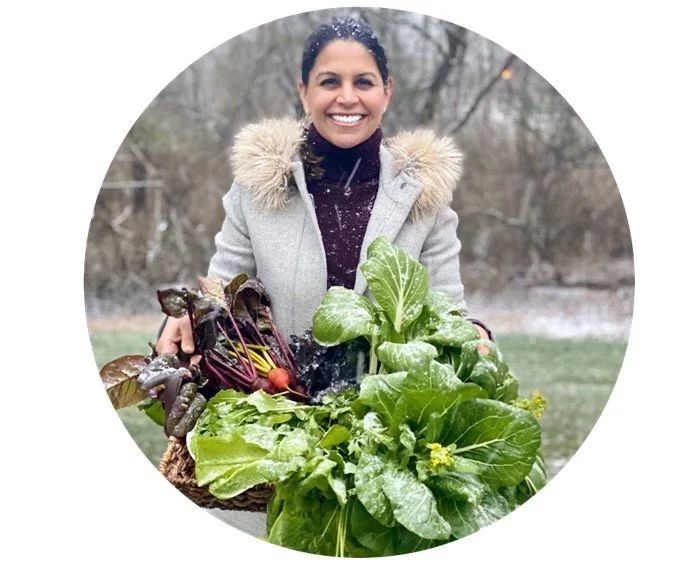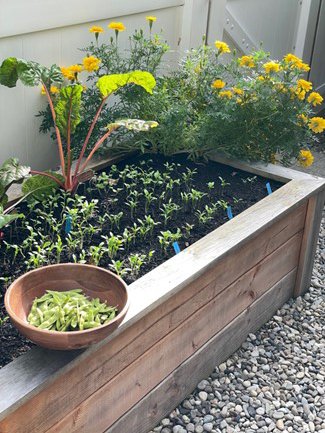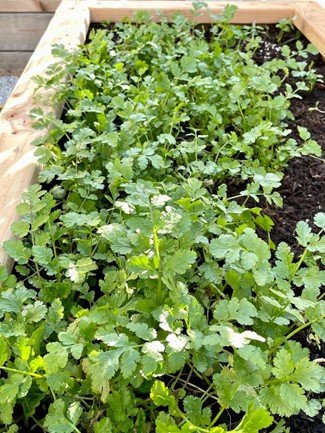Grow More Food: Fall/Winter Gardening & Season Extension Tips
December Harvest of Beetroot, Kale, Bok Choy, Carrots, Radishes, Lettuce, Arugula & Cilantro from my backyard garden in New Jersey, Zone 6B.
ABOUT RESH GALA
Resh is a small space organic gardener from New Jersey and is passionate about encouraging people to grow their own food and live their best lives.
She is also the founder and owner of minority and woman owned business, Hundred Tomatoes LLC, that designs and installs organic kitchen gardens in NJ and surrounding areas.
An Allotment Gardener at non-profit organization Duke Farms Community Gardens (part of the Dorris Duke Foundation), she also has a MBA degree in Marketing and Strategy.
Named 2020 Gardener of the Year by Burpee Home Gardens. Find her on Instagram @reshgala
THE WHY
MORE FOOD:
Are you growing food this fall and winter? I hope you are because it’s the absolute BEST TIME to grow a vegetable garden! Most people think that they can only grow food between their ‘Last Frost Date’ in spring and their ‘First Frost Date’ in autumn. But there are so many fantastic “cold-hardy” and “frost tolerant” plants that you can grow in the cooler months and yes, even in the snow! And incorporating some simple season extension tricks can enable you to grow more food and harvest and enjoy veggies well past your first frost date!
LOW PEST PRESSURE:
One of the BEST parts of growing in the cold season is a significant reduction in pest pressure. If you’re tired of gardening in summer because of the endless battle with aphids, spider mites and lantern flies, then fall and winter is YOUR GROWING SEASON! Bugs and pests very much dislike the cold weather and will rarely bother your plants.
ENJOYABLE WEATHER:
Autumn is truly a wonderful time to be in the garden - crisp, fresh air, blue skies and the big bonus - you don’t get hot and sweaty from doing gardening chores!
SWEET TASTING VEGGIES:
Did you know that fall grown carrots, beets, kale, spinach and other vegetables actually taste sweeter than the same ones grown in summer? This is because the cold temperatures convert some of the starches into sugars as a defense mechanism to prevent them from freezing.
LOW TO NO WATERING REQUIREMENTS:
A bit of a science lesson here: The biggest advantage of growing food under cover is that you will rarely need to water your plants in winter. Nature is amazing! When veggies are grown under the cover of hoops and farm grade plastic (think mini greenhouse or terrarium), plants inside transpire and release water vapor into the atmosphere. This water vapor touches the cold plastic on top, condenses and falls back down as “rain” which moistens the soil and keeps the roots alive. And the cycle continues. Of course there are always exceptions - if you find that your soil is dry or have an unusually warm winter, then please use your judgment and water your plants.
EARLY START IN SPRING:
Many cold hardy veggies grown in fall are usually one of the first ones to grow back in spring. My fall planted spinach, kale, cilantro and parsley are some of the first crops that I harvest in spring.
THE WHAT
Now that you know why you should grow food in fall and winter, below is a list of a few fantastic cold hardy crops that can tolerate a frost. Please keep in mind that different plants have a different degree of frost tolerance. For example, plants like Brussels sprouts, broccoli, kale and cabbage are most cold hardy (withstanding temperatures as low as 28 to 25 degrees Fahrenheit without cover), while tender leafy greens such as lettuce and arugula can only handle a very light frost.
THE WHEN
Timing is everything when it comes to a fall/winter garden, especially if you live in an area that receives frost, snow and below freezing temperatures. Most winter gardens are planted in mid to late summer and some in early fall. How does one know what to plant when? Well it’s easy:
PLANT THESE FIRST:
Veggies that take the longest to grow and mature should be planted earlier. For example: cabbages, broccoli, Brussels sprouts and carrots take anywhere from 75 to 90 days to mature and should be planted 10 to 12 weeks before your first frost date.
PLANT THESE NEXT:
Quick maturing veggies should be planted later in the season. For example lettuce, arugula, and radishes take approximately 25 to 40 days from seed to harvest and can be planted 6 to 8 weeks before your first frost date.
PLANT THESE LAST:
If you’re burnt out from gardening this year and want to grow something that you can plant and forget, then may I recommend garlic? It is an easy crop to plant 2 weeks before your first frost and makes an excellent companion plant too, deterring pests and insects. Fall planted garlic does not need to be covered at all or protected from the snow and elements. Keep in mind that it is typically harvested in mid-summer the following year, so if you’re a small space gardener, then plant garlic as a border crop instead.
THE HOW
Now that you know what to plant and when to plant it, let’s discuss the various ways in which you can extend your growing season. I start covering my plants when temperatures go below 40 degrees Fahrenheit and remove/open up the covers when temperatures are warmers (especially during the day).
Fleece Fabric:
Fleece fabric offers light protection but allows rain to go through. This is a good option to use in areas that experience a mild winter or in early fall.
Hoops & Farm Grade Plastic:
For greater degree of cold protection, install hoops and 6 mil clear farm grade plastic to cover your plants. Hoops can be made of either 10’ long, ½” thick PVC pipes (that are pliable/bendable) or 10’ long ½” thick EMT pipes (electrical metal conduit pipes) bent using a hoop bender. Pull the plastic tautly over the hoops and secure with snap clamps or clips. I usually install 3 hoops per 4’x4’ raised bed and secure with clamps or clips. Did you know that using farm grade plastic creates a greenhouse effect and raises the temperatures inside by 1 to 1 ½ zones? So if you’re in zone 6B, the plants inside will feel like they are in zone 7B or zone 8!
Clear Plastic Storage Bins:
Clear, large plastic storage bins can turn into great emergency covers for your plants. Prevent them from flying off in the wind by securing them with a brick or heavy stone on top.
BONUS TIPS
Plant Intensively:
Plants huddled close together keep each other warm. It’s true! Think of penguins in Antarctica - it works for them too!
Mulch:
Mulch your fall crops with a heavy layer of compost or straw to insulate the soil as much as possible and to prevent it from freezing.
Fertilize:
Fertilize your plants in fall before the ground freezes. I prefer a gentle liquid organic fertilizer such as Earthworm Casting Tea.
Hope you try these easy season extension tips and grow more food year-round!








